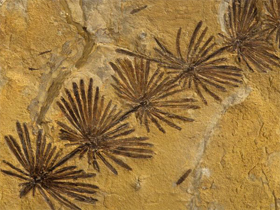|
|
This is the name given to the remains or traces of a plant or animal preserved in the Earth’s strata. The word itself is of Latin origin, signifying to dig. Fossils collected from all over the world provide detailed information about the organisms that have lived on Earth since life began.
Under normal conditions, when an animal dies, all traces of it quickly disappear. The body may be removed by scavengers or broken down by micro-organisms, after which no trace of the animal is left. Remains are only preserved under exceptional circumstances.171 For that reason, only a very few organisms are preserved as fossils after they die. The fossilization of any organism generally depends on two conditions being met:
The most efficient environment for fossilization is a muddy, clay-rich one. After any organism that falls—or is dragged—into such an environment, the elements around harden, forming a mould. Later, the soft tissues of the organism itself generally disappear, due to decay, but the mould or cast remains. If minerals subsequently fill the hollow, the result is an exact copy of the organism’s outline. If the body parts are replaced with different minerals, this is known as petrifaction. So perfect can this petrifaction sometimes be that anatomical studies can even be carried out on fossilized specimens.172
Fossils may include not only the hard parts of living things such as bones, teeth, and shells, but can even preserve moulds of various organs and even suggest lifestyles. The shape of bones and how muscles were attached to them can tell us an animal’s posture and how it moved.173
Fossil research also enables us to obtain information about extinct animals and plants, and when these particular species lived. However, evolutionists also regard fossils as vital in terms of constructing genetic relationships between living things and indicating similarities in their development. They use fossil remains to prove their claim that living things supposedly developed from one another in stages. However, although some 80% of the fossil records have today been uncovered, they have no evidence to offer, apart from a few fossils that subsequently proved to be fakes or the product of distortion. In fact, the fossils in the layers of the Earth confirm that living things have existed in their perfect forms ever since they were first created. (See Fossil records, below.)
The gaps in the fossil record are real, however. The absence of a record of any important branching is quite phenomenal. Species are usually static, or nearly so, for long periods, species seldom and genera never show evolution into new species or genera but replacement of one by another, and change is more or less abrupt. 174
171 Bilim ve Yaşam Ansiklopedisi, Istanbul: Geli?im Publishing, 1976, p. 4.
172 Prof. Dr. Ali Demirsoy, Ya?amF5n Temel KurallarF5, Genel Biyoloji/Genel Zooloji, Vol.I, Chapter I0, Ankara, 1993, pp. 629-630.
173 Ibid, p. 629.
174 Robert Wesson, Beyond Natural Selection, Cambridge, MA: MIT Press, 1991, p. 45.



